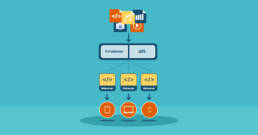
5 Benefits of a Headless CMS

December 22, 2021
share this post
A few weeks ago, we broke down the mechanics of a headless CMS to explain what, exactly, is a headless CMS and why more organizations and brands are turning to a headless CMS to power their digital ecosystem.
Since then, we have had a few of our clients and prospects reach out to request more information about how a headless CMS can improve their website. In today’s post, we’re diving further into this topic to outline five of the key benefits of a headless CMS.
The best part? These benefits are industry-agnostic. So, whether you’re B2B, F&B, or non-profit, your company can experience the performance-improving aspects of a headless CMS.
5 Industry-Agnostic Key Benefits of a Headless CMS
Move Beyond “Pages”
In a traditional CMS environment, it’s typical to think of your website as a collection of pages. You’ve got your homepage, contact page, marketing pages, sales pages, landing pages, etc. New content is typically added to the site as a new page. A headless CMS, on the other hand, frees you from having to think about pages and instead focus on the content itself.
Let’s take a blog post as an example. In a traditional CMS, a blog post (and all of the elements that go into creating it) might be considered a single piece of content. The title, images, body, all of it would exist as a single piece of content.
With a headless CMS, each content element is treated as its entity. API’s then control what specific elements will populate an app or website.
This allows you to more easily showcase, manage and create your content as once the content is created, it can be disseminated across all of your platforms based on the specific needs of each platform’s design.
More Security Over Third-Party Integrations
Unlike a traditional CMS (where both the front-end and back-end systems are connected), a headless CMS separates the content from the presentation of the content. This creates a smaller area for a possible attack. Each system is separate, so there’s less threat exposure to the system as a whole.
It also helps to ensure that any security breach is limited in its ability to interact with – or damage – other areas of your environment. If someone manages to force entry into your front end, they still wouldn’t be able to access your content or the APIs that power your experience.
Additional Development Flexibility
Is one of your developers fluent in Ruby while another prefers PHP? A traditional CMS environment would have you choose a single language for your team. However, with a headless CMS, the content is dynamically populated through an API, which means that developers have the freedom to choose the front-end tooling they prefer.
Not only can this make your development team happier (and their job easier), but it gives you the flexibility to use the best systems possible to build your digital platform. As a bonus, this also means that you’re less likely to experience any outages caused by using inefficient systems simply because that’s the language or tool you’re grandfathered into using.
Scalable Solution that Grows When You Grow
Show of hands, how many of you are tired of constantly building new websites to meet the ever-expanding needs of your organization? Whether it’s the content that is getting stale or the back-end platform that is no longer cutting it, a traditional system often means burning an existing site to the ground before standing up a new experience.
This is an expensive, inefficient model. It also outlines one of our favorite benefits of a headless CMS. Since the back end and front-end are separate entities, your team can expand and enhance either area to scale with you as you need them with minimal downtime.
More Testing Opportunities
It’s rare to launch with a perfect digital experience. There’s always an element that can be tweaked to squeeze a bit more performance out of your system. A headline here, a new animation or video there, the more you can test, the more you can improve the conversion rate of your site.
Whether it’s improving the front-end of your website or leveraging your back-end shared content library to populate additional customer touchpoints (applications, in-store experiences, etc.), a headless CMS provides your team with more opportunities to test, iterate, and improve your user experience.
Is A Headless CMS Right for You?
As with any technology, a headless CMS is not a magic bullet for every company within every industry. If you’re powering a simple brochure website, a headless CMS might be a bit of an overkill. However, if you’re managing multiple platforms or want to take your digital footprint to the next level, a headless CMS could help maximize your return on investment while minimizing your costs.
To learn if a headless CMS would benefit your company, give us a call. We’ll be happy to explore your unique needs and determine if a headless CMS is suitable for you.
Want to learn more about the digital trends that will be shaping 2022. Download our newest resource, “5 Digital Trends to Know in 2022.”